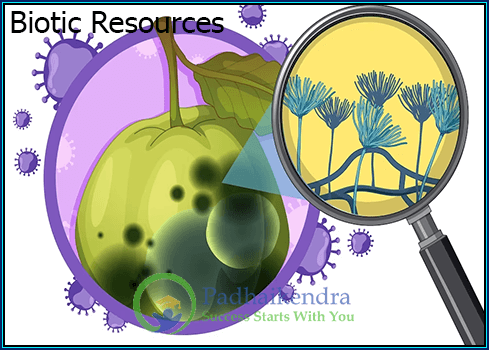In the intricate web of life on Earth, resources can be broadly categorized into two fundamental types: biotic and abiotic resources. These resources support both living organisms and physical processes that drive Earth’s systems. This article delves into the definitions of these resources and their immense importance in environmental systems.
Definition of Biotic and Abiotic Resources
Biotic resources: Living organisms, including plants, animals, fungi, and microorganisms, play crucial roles in maintaining ecosystem stability and food chains.
Abiotic resources: Non-living components like minerals, water, air, sunlight, and physical factors like temperature and soil composition provide the foundation for life.
Importance of Biotic and Abiotic Resources in Environmental Systems
- Ecosystem Functioning: Plants use photosynthesis to convert sunlight into energy and oxygen, influencing atmospheric composition and global climate.
- Nutrient Cycling: Microorganisms decompose organic matter, releasing essential nutrients back into the soil, crucial for healthy ecosystems and agriculture.
- Biodiversity: Diverse species ensure ecosystem resilience, preventing imbalances if one species faces threats or extinction.
- Habitat Creation: Biotic resources, like trees, provide habitats for various organisms, contributing to an area’s biodiversity.
- Abiotic Resource Influence: Abiotic factors, like soil type, influence the distribution of biotic resources and the organisms that rely on them.
- Sustainable Development: Responsible use of both resources is essential for maintaining ecological balance and benefiting present and future generations.
Biotic Resources: Living Components
Definition & Examples: Biotic resources include plants, animals, and microorganisms that inhabit Earth. They provide oxygen, food, shelter, and contribute to nutrient cycling and ecosystem dynamics.
Examples: Plants, Animals, Microorganisms, Agricultural Resources, Ecosystems
Classification:
- Renewable (fisheries, agricultural crops, timber)
- Non-renewable (endangered species, old-growth forests, slow-reproducing species) biotic resources.
Role of Biotic Resources in Ecosystems
- Food Web: Complex interactions regulate population sizes and nutrient cycling.
- Biodiversity: Ensures ecosystem resilience and prevents imbalances.
- Pollination: Animals contribute to plant reproduction and fruit production.
- Nutrient Cycling: Decomposers recycle nutrients, supporting plant growth.
- Habitat Creation: Biotic resources create and modify habitats.
- Ecological Balance: Predators help control prey populations, maintaining ecosystem health.
Abiotic Resources: Non-Living Components
Definition and Examples: Abiotic resources include minerals, water, air, sunlight, and soil, providing the foundation for life.
Classification:
- Renewable (solar energy, wind energy, freshwater)
- Non-renewable (fossil fuels, minerals, geothermal energy) abiotic resources.
Importance of Abiotic Resources in Human Activities
- Energy Production: Fossil fuels, renewable energy sources, and geothermal energy power industries and households.
- Agriculture: Soil, water, and sunlight are crucial for agricultural productivity.
- Industrial Processes: Minerals and metals support manufacturing and technological advancements.
- Infrastructure: Water and soil aid in developing infrastructure.
- Climate Regulation: Atmospheric composition affects climate patterns.
Interdependence of Biotic and Abiotic Resources
- Biotic and abiotic resources are interconnected and essential for ecosystem dynamics.
- Relationships include nutrient cycling, energy flow, habitat creation, and adaptation.
Difference Between Biotic and Abiotic Factor:-
| Aspect | Biotic Components/Factors/Resources | Abiotic Components/Factors/Resources |
|---|---|---|
| Definition | Living organisms and their interactions | Non-living elements and physical factors |
| Examples | Plants, animals, fungi, microorganisms | Minerals, water, air, sunlight, temperature |
| Source of Energy | Autotrophs (plants) are primary energy sources | Sunlight is a primary energy source |
| Interactions | Predation, competition, symbiosis | Weathering, erosion, chemical reactions |
| Growth and Reproduction | Organisms reproduce and grow | No growth or reproduction in the traditional sense |
| Adaptation | Organisms adapt to their environment | Abiotic factors can influence adaptation |
| Nutrient Cycling | Decomposers recycle nutrients in ecosystems | Abiotic factors affect nutrient availability |
| Role in Ecosystems | Key roles in food webs, nutrient cycling | Influences weather patterns, energy flow |
| Sustainability | Some are renewable (plants, animals) | Some are renewable (solar energy) |
| Some are slow-renewable (large mammals) | Some are non-renewable (fossil fuels) | |
| Some are non-renewable (endangered species) | Some are non-renewable (minerals) | |
| Impact on Climate | Can influence local climate patterns | Influence global climate through greenhouse gases |
| Habitat Creation | Create and modify habitats for other organisms | Abiotic factors like soil impact habitat |
| Conservation Efforts | Protection, sustainable harvesting | Efficient extraction, recycling, balanced use |
| Examples | Plants, animals, fungi, bacteria | Minerals, water, air, sunlight, soil |
Impact of Resource Depletion on Ecosystems
- Biotic Resource Depletion: Deforestation, overfishing, and poaching disrupt ecosystems and lead to population imbalances.
- Abiotic Resource Depletion: Fossil fuel and mineral depletion disrupt energy sources and contribute to environmental degradation.
- Pollution: Air, water, and soil pollution disrupt resource interactions and degrade ecosystems.
Conservation and Sustainable Management
- Biotic Resource Conservation: Habitat preservation, species protection, and sustainable harvesting are vital.
- Abiotic Resource Management: Efficient extraction, recycling, and balanced resource use promote sustainability.
Challenges and Issues
1. Overexploitation of Biotic Resources: Deforestation, overfishing, and poaching threaten biodiversity.
2. Depletion of Non-Renewable Abiotic Resources: Fossil fuel and mineral depletion disrupt ecosystems.
3. Pollution and Impact: Air, water, and soil pollution affect both resource types.
Addressing Challenges: A Call to Action
- Sustainable Practices: Responsible extraction, conservation, and emission reduction are crucial.
- Conservation and Protection: Protected areas and wildlife reserves safeguard biodiversity.
- Renewable Energy: Transition to renewable energy sources to reduce environmental impact.
- Education and Advocacy: Raise awareness and promote environmentally conscious choices.
- Technological Innovation: Develop eco-friendly technologies and alternatives.
The delicate dance of biotic and abiotic resources sustains life on Earth. Addressing challenges requires collaborative efforts to ensure the longevity of these resources and a balanced environment for present and future generations.





